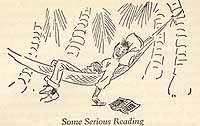

- Grand Bahama in 1887 from L. D. Powles The Land of the Pink Pearl or Recollections of Life in the Bahamas.
- Grand Bahama in 1891 from Stark's History and Guide to the Bahama Islands.
- Grand Bahama in 1917 from Amelia Defries In a Forgotten Colony
- Grand Bahama in 1924 from The Tribune Handbook
- Grand Bahama in 1926 from Mary Mosley The Bahamas Handbook.
- Grand Bahama in 1931 from Nassau and the Treasure Islands of the Bahamas
- Grand Bahama in 1934 from Maj. H. M. Bell Bahamas: Isles of June
- The Bahamas in 1964 from Benedict Thielen The Bahamas-Golden Archipelago
- Grand Bahama in 1967 Moral Panic, Gambling. and the Good Life
Grand Bahama in 1858
(With thanks to Donald Duncombe for alerting me to the availability of the report reprint)
THE GRAND BAHAMA
All the settlements are on the south side of the Island, and their plantations run from the east to the west point. There are no good harbors on this side, but on the north, vessels lie under the lea of the cays.
Hawk’s Bill Creek runs across the Island, dividing it in the south, excepting where there is a bank of sand and low mangroves which close it in. Were the bank cut through for about 100 yards, and a few feet of rock cut through, a place of refuge for vessels would be formed on this side, and the tides would eventually clear a channel through the mangroves and accumulated mud. Near this spot is Eight Mile Rock Settlement, where there is no public road, only a very winding path through private property. To obviate the great inconvenience felt in consequence, I would suggest that each land owner should give up a strip of land, thirty feet wide, to the south of this plantation for a road, in consideration of the same quantity being given him on the north side of his property. The proprietors are very desirous to obtain this road, and those to whom I spoke expressed their willingness to make this exchange.
They raise cattle and horses to some extent, and cultivate corn, potatoes, &c. There are abundance of fish, lobsters, and turtle; of the latter, they caught last year about 280 loggerhead, 300 green, and 40 or 50 hawk’s bill. The loggerhead when salted or pickled will keep as well as pork.
The inhabitants of this Island and the cays around, only need encouragement to induce them to enter / largely into the business of catching and preserving the turtle, which would soon increase, and might become a profitable trade.
There are seven wrecking vessels and two schooners belonging to Grand Bahama. For the fortnight before I visited it, there had been some fifty sail of wrecking vessels cruising about the great wrecking ground near Sandy Cay. On this cay there is good water. On the north side of the Grand Bahama is some sponging ground; the best sorts obtained there, are the sheep wool, boat, and velvet sponges.
There is a good stone church and a Baptist chapel at Eight Mile Rock settlement, and a very good public school.
The burial ground is unenclosed.
Since visiting Abaco and Grand Bahama, I am more than ever convinced of the imperative necessity that exists for steam communication to be introduced in the Bahamas, if the many and varied resources of its numerous islands and cays are ever to be developed for the support of the inhabitants, and the general prosperity and advancement of the colony.
The great variety of productions in the Bahamas, when considered as a whole, if there existed an interinsular steam communication, become available to all, and the cultivation of the land and development of the many valuable resources, would speedily follow the power of obtaining a sure market. At present some cays are, at times, absolutely destitute of the very necessities of life; while at others, perhaps not many miles distant, there is a superabundance of the very articles required. The inhabitants / fear to incur the expense of agriculture, curing of fish, turtle, &c. feeling that no opportunity may offer for sending the produce of their labor to Nassau, or elsewhere. They are not wealthy enough to run the risk, and such pursuits are abandoned, greatly to the injury of the whole country through which the produce of every part could circulate, were there regular and certain means of communication and transfer.
I append to this report the estimates for the proposed works. [not included in printed document]
I have the honor to be, sir,
Your most obedient, humble servant.
THOMAS C. HARVEY, C. E.
The Honorable C. R. Nesbitt, Esq.
Colonial Secretary,
&c. &c. &c.
Thos. Chapman Harvey, Esq. Official Reports of the Out Islands of the Bahamas. Nassau: T. Darling, J.M. Connor, Thomas Williams, 1858, pp. 58-60.
